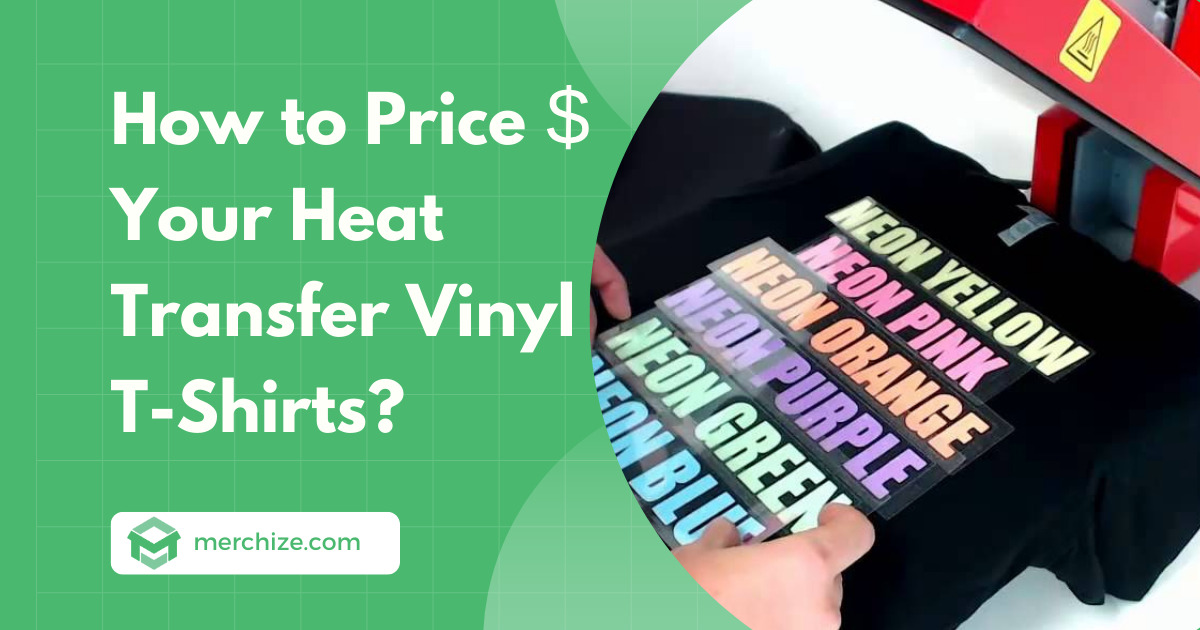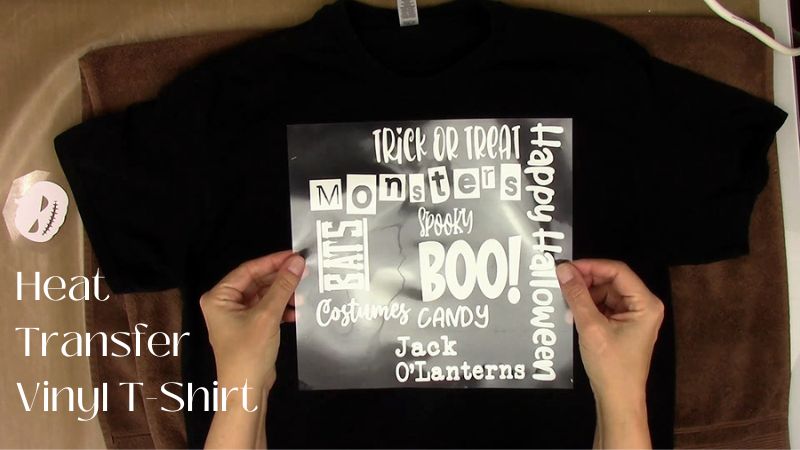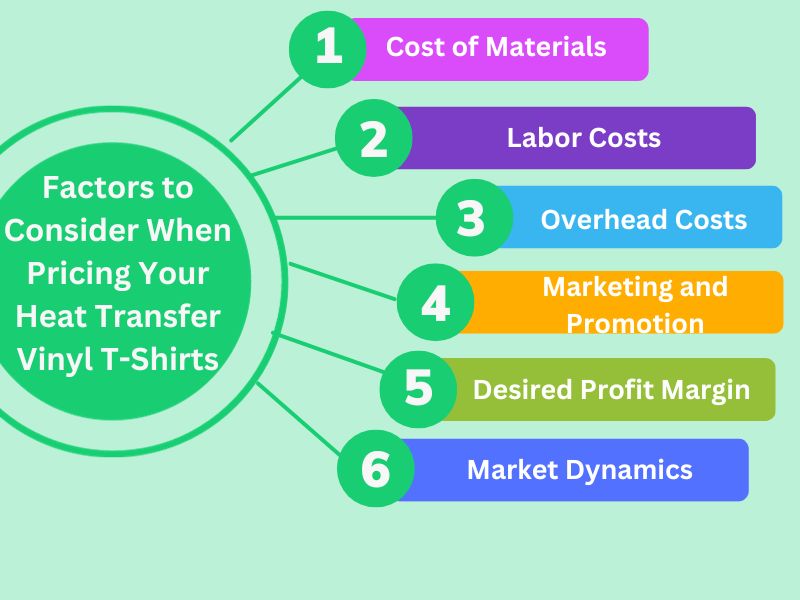Contents
In the realm of print on demand, Heat transfer vinyl (HTV) is a popular way to customize t-shirts and other apparel. The ability to produce vibrant and intricate designs without breaking the bank has made them a favorite among both businesses and hobbyists. Yet, a question that often hovers in the mind of producers is: How do you price your HTV t-shirts to ensure profitability? Let’s dive in.
Heat Transfer Vinyl T-Shirt Pricing Chart Sample
When you’re thinking of selling HTV T-Shirts, getting the prices right is key to earning while staying in the game. Here’s a sample price guide showing price levels depending on quantity:
| Number of Shirts | Base Price |
|---|---|
| 1 | $15-$25 |
| 2-4 | $12-$20 |
| 5-9 | $10-$15 |
| 10+ | $8-$12 |
This chart, however, is merely a starting point. As the market changes, material prices change, and shoppers change their minds, you gotta check and tweak your pricing now and then. Also, things like brand name, unique designs, and how good it is can also change how you price in the HTV tee world.
How to Calculate Your DIY Heat Transfer Vinyl T-Shirt Prices
Pricing a product goes beyond just calculating the raw material cost. In the realm of custom heat transfer vinyl t-shirts, it’s a blend of understanding both your tangible and intangible inputs. To decide how much for your tees, making sure you earn without making it pricey for who you’re selling to, it’s super important to think about loads of things to consider.
Identifying Your Costs:
- Material Costs: This typically encompasses the blank t-shirt, the heat transfer vinyl, and any additional materials such as transfer paper.
- Labor Costs: Factor in the time spent on design creation, cutting the vinyl, and pressing it onto the t-shirts. This is very important. Many sellers underprice because they only consider materials. Labor cost (your time or staff pay) must be added to estimate profitable pricing.
- Overhead Costs — These are indirect costs, like electricity, workspace, amortized equipment costs, consumables, packaging, and rent.
- Marketing & Promotion — ads, photography, listing fees.
Summing Up the Costs:
Add together the material, labor, and overhead costs to derive a total cost per t-shirt. Using the given example:
- Material cost: $5
- Labor cost: $2
- Overhead cost: $1
Total cost = $5 (material) + $2 (labor) + $1 (overhead) = $8
Factoring in Profit Margin:
The next step is to determine how much profit you want to make from each sale. If you’re targeting a 20% profit margin, you’d calculate the profit per t-shirt as:
- Profit per t-shirt = 20% of the Total cost
- Profit per t-shirt = 0.20 × $8 = $1.60
Then, to get the sale price, you’d add this profit to your total cost:
- Sale price = $8 (total cost) + $1.60 (profit) = $9.60
To keep things straightforward for your customers, consider rounding off the price. So, you might want to price the t-shirt at $10.
Consider External Factors:
While the above process gives you a baseline, remember to account for external factors like market demand, competition, and perceived value. These factors might encourage you to tweak the price slightly.
How To Calculate Your Print on Demand Heat Transfer Vinyl T-Shirts
1. Decoding Your Expenses
If you are selling T-shirts online via print on demand, you won’t have to consider materials, labor, and other related production costs. But instead, you will have to factor in other expenses like:
- POD Service Expenditures: The third-party POD service usually determines the base price, encompassing the costs of the blank t-shirt, the printing, and occasionally, shipping.
At Merchize, we provide a wide variety of heat-press T-shirt options at super competitive prices. You can get a T-shirt printed on demand at prices as low as $5-6.
- Design Expenditures: This could include costs incurred by hiring a designer or obtaining design licenses.
- Online Platform and Advertising Expenditures: This takes into account expenses associated with advertising, platform fees (for platforms like Etsy or Shopify), and any potential transactional fees.
2. Tabulating the Accumulated Costs
Using the provided data:
POD service base price: $6.99 Design cost (assuming you’re paying for design services or licenses): $2 Marketing/platform fees (assuming a 10% fee on your sale price, we’ll compute this subsequently): 10% of final sale price
3. Determining Your Desired Profit Margin
For this demonstration, we’re working towards achieving a sale price of $23.99.
Starting with our base costs:
Pre-marketing costs = $6.99 (POD service) + $2 (Design) = $8.99
Let’s define the final sale price as:
x = $23.99
Considering the 10% marketing/platform fees:
0.10 * x = $2.399 (fees)
So, our aimed profit per shirt is:
Profit = x – ($8.99 + $2.399) Profit = $23.99 – $11.389 = $12.601
4. Finalizing the Sale Price
Taking into account the calculations and desired profit, we’ve determined a sale price of $23.99 for the POD t-shirt.
By really thinking about all these things and checking back on them now and then, you make sure your vinyl tee business makes money and that you’re giving folks their money’s worth.
Which is more profitable: Print on Demand or DIY?
This is a very common trap: buying a heat press (or a DTF/DTG printer) before confirming demand and ending up with unused equipment.
So how do you know which option, print on demand or DIY heat press T-shirts, is suitable for you?
Here is a practical rule of thumb:
Outsource (POD or local printers) while testing designs and channels. Buy equipment only when you have reliable repeat orders (rough benchmark: 50–100 shirts/month, depending on margins).
You can use the break‑even formula below to make the decision data‑driven to know if it’s worth investing in your own printing machines.
Break‑even units = Equipment cost ÷ Savings per shirt
Example:
- Equipment cost = $900 (heat press + cutter + small extras)
- POD per shirt = $16 (product, print, shipping)
- In‑house variable cost per shirt (materials + labor) = $9
- Savings per shirt = $16 − $9 = $7
=> Break‑even = $900 ÷ $7 ≈ 129 shirts
If you expect to sell more than 129 shirts over the useful life of the press (or in a reasonable time window, for example, 6 to 12 months), buying may pay off. Otherwise, keep using POD until demand grows.
Why choose DIY Heat-press T-shirts?
Doing heat-press T-shirts yourself gives you full control over quality, materials, and turnaround — you can tweak ink, garment brands, pressure, and finish until a design looks exactly how you want.
For small runs, custom one-offs, local pop-ups or premium pieces the higher per-item margin and ability to offer immediate personalization make DIY attractive. It’s also a great way to learn production skills that let you fix problems fast and iterate on samples without waiting on a supplier.
If you decide to make heat-press T-shirts at home, expect some upfront friction and ongoing practical issues. Below are real challenges many sellers run into — read them before you commit so your pricing and time estimates are realistic:
Also, to make an informed decision, you should also consider other challenges to make your own heat-press t-shirt at home:
- Cheap gear limitations: Low‑cost heat presses and printers can be inconsistent or break under heavier use. A reliable mid‑range heat press (reputable brand, swing‑away/clamshell) often saves time and frustration.
- Printers clog: DTG and sublimation printers can clog if unused for days. Plan for regular maintenance cycles, cleaning supplies, and test prints.
- Supplies & spare parts: Keep spare blades, Teflon sheets, transfer tape, and a small maintenance kit. Unexpected repairs and consumables are real costs.
- Training time: Expect a learning curve for color management, cutting/weeding techniques, pressure, and temperature tuning.
- Add a small maintenance budget (for example, $5–$20/month at low volume) into overhead calculations until you understand real usage.
Why choose Print on Demand Heat-press T-shirts?
Print-on-demand (POD) removes almost every production headache: no inventory, no equipment purchases, and no daily maintenance.
Tips to Make Your Heat Transfer Vinyl T-shirt Business Profitable
Know your audience and competition
- Understand Your Target Customer: Research the spending habits and preferences of those you want to serve. Budget-conscious students may expect lower prices than style-focused professionals.
- Analyze Your Competition: Study how competitors price and position their shirts. While you’ll differentiate, this intelligence should inform your strategy.
Choose your sales channels & niches
- Start local: craft markets, school teams, local stores, event merch. Local buyers often value quick turnaround and customization.
- Niche targeting: focus on pet owners, hobby groups, local sports, clubs, and causes. Niches allow higher price points and easier marketing.
- Online platforms for testing: POD marketplaces (Printful, Teespring), Etsy, and social media shops are excellent for validating designs before purchasing stock or equipment.
Increase perceived value (so you can price higher)
- Branded packaging and a thank‑you card: Adds $0.50–$1 to cost but can increase perceived value significantly.
- Customization: Offer optional add‑ons (names, numbers, simple personalization) for extra fees.
- Bundling: Pair shirts with stickers or a small tote to increase average order value.
- Limited runs and special effects: Use specialty HTV (glitter, metallic) or small limited editions to justify premium pricing.
Keep Quality in control & avoid returns
- Always run a test print on the exact garment and HTV before full production.
- Keep a settings log (temperature, time, pressure, backing used) for each garment type.
- Inspect adhesion and wash test (when possible) for new HTV materials.
- Clearly state care instructions on the product page and inside packaging.
- Have a straightforward returns or reprint policy for issues like peeling, misprints, or wrong sizes.
Offer strategic discounts
- Offer Volume Discounts: Give discounts for bulk orders over specific quantities. This caters to high-volume needs while improving cash flow as you scale.
- Run Periodic Promotions: Leverage sales, deals and promotions to create excitement and drive traffic. Attract new customers while rewarding existing ones.
In short, getting the price right for heat transfer vinyl t-shirts is super important for your business to boom. By taking a good look at costs, understanding your peeps, and using all the inside info, you can achieve a balanced price point that ensures profitability while appealing to a broad customer base.







